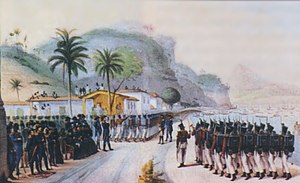Luso-Brazilian invasion
| Portuguese conquest of the Banda Oriental | |||||||
|---|---|---|---|---|---|---|---|
 Portuguese Troops sent to Montevideo |
|||||||
|
|||||||
| Belligerents | |||||||
|
|
|
||||||
| Commanders and leaders | |||||||
|
|
José Gervasio Artigas Andrés Guazurary Fructuoso Rivera Fernando Otorgués Pedro Campbell |
||||||
The Portuguese conquest of the Banda Oriental was the armed-conflict that took place between 1816 and 1820 in the Banda Oriental, for control of what today comprises the whole of the Republic of Uruguay, the northern part of the Argentine Mesopotamia and southern Brazil. The four-year armed-conflict resulted in the annexation of the Banda Oriental into the United Kingdom of Portugal, Brazil and the Algarves as the Brazilian province of Cisplatina.
The belligerents were, on one side, the "artiguistas" led by José Gervasio Artigas and some leaders of other provinces that made up the Federal League, like Andrés Guazurary, and on the other, the troops of the United Kingdom of Portugal, Brazil and the Algarves, directed by Carlos Federico Lecor.
On the naval front, the conflict far exceeded the Rio de la Plata and the Argentine coast to spread globally, as the Insurgent Privateers, most notably under the flag of Buenos Aires and flag of Artigas, harassed Portuguese and Spanish ships in Europe, Africa and the Caribbean.
The causes that led King John VI of the United Kingdom of Portugal, Brazil and the Algarves, whose court had been installed in Rio de Janeiro since 1808, to embark on the invasion of the Banda Oriental can be divided into general and circumstantial.
Among the first is located in the main place, the former Portuguese aspiration to bring the frontiers of Brazil to the coast of Rio de la Plata (Portuguese: Rio da Prata), arguing that it matched the Tordesillas line by which Spain and Portugal had divided the world in 1494. For that reason, the region of the Rio de la Plata was a border area between Spain and Portugal, and as such, a highly conflictive area and theater of bloody battles over the centuries, even after the American colonies became independent of the European powers.
...
Wikipedia
